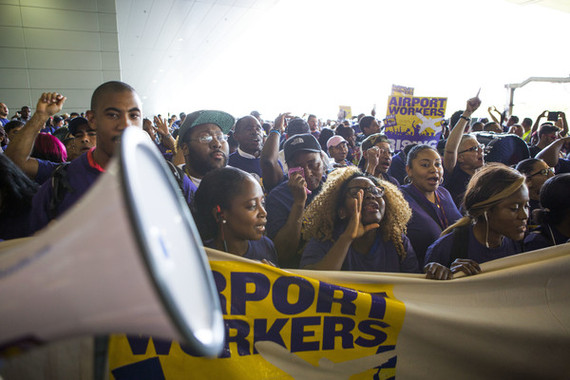A brilliant essay in the New York Times Magazine by Binyamin Appelbaum on Sunday asks a simple question.
When will elected officials and candidates stop talking about the manufacturing jobs people did yesterday and start talking about the service jobs people do today?
It's a call for a reality check.
Around 80 percent of jobs in this country are in the service sector, according to Appelbaum. Last year, there were 820,000 home healthcare workers in America--and only 64,000 steelworkers. Average annual wages for home health aides? $22,870 per year.
It's the same story for service workers in other industries. Always underpaid, often overworked, often abused.
For example, Cycei Monae, who said she quit her $8.50 job at McDonald's in Flint, Michigan after her supervisor showed her a picture of his genitals.
Or Eduardo Sanchez, a San Diego security officer who talks about trying to make it on $11.25 per hour with $10,000 in student loans.
Or Charles Wells, a wheel chair attendant at Reagan National Airport in Washington, DC, who is paid so little he often sleeps at the airport because he can't afford to pay for the metro ride home.
This is our reality. We live in a service economy and some 64 million workers in this country are paid less than $15.
So why aren't officials talking about how to improve the jobs that most Americans actually have? Why do they keep talking about steelworkers and plumbers and welders? Why do they almost never talk about janitors, security officers, airport workers, home care workers, child care workers, fast food workers, and nail salon workers?
As with many questions about the 2016 election, the answer, in my view, is race. Politicians and the media have not caught up to the new reality. At the heart of our economy is a new working class. "Instead of white men who make stuff," Appelbaum writes, "the group is increasingly made up of minority women who serve people."
Yet in the 2016 election, this new working class has been largely ignored. In past election cycles, "Joe at an Iowa diner", a white, rural American, usually got the privilege of articulating the nation's dreams. But in this election cycle, the country is frustrated--especially about jobs. Who gets to articulate that frustration? Again, it's white folks--through countless stories about former manufacturing workers of the industrial Midwest.
I'm from Ohio. My father made steel for a living. I know the suffering of displaced manufacturing workers and their families in the Midwest. It is very real. But these people should not be the only ones allowed to speak about the economic challenges we face.
We live in a multiracial democracy. If we are to raise wages and build broad prosperity, today's working class--service workers, people of color, women--must be visible on our national stage.
How do we do that? We mobilize.
In a recent New York Times op-ed, "How to Build a Democratic Majority that Lasts," Steve Phillips persuasively argues that, in politics, television ads don't work. What matters is person-to-person contact--phone calls, door knocks, and rides to the polls.
This fact gives me heart. It tells me that we--working people and people of color--still have the upper hand, if we stick together.
As powerful as the billionaires are--and they are powerful--and as unfair as their advantage may be, they cannot simply plunk down cash and buy elections. Sure, they can rent our screen-illuminated eyeballs for 30 or 60 seconds. But they cannot buy our hearts and minds. They cannot buy our democracy.
We can use the tools of our democracy--our right to assemble, our right to speak freely, and our right to vote--to solve our economic challenges. That's why until November 8, tens of thousands of SEIU members are working together to identify, talk to, and turn out voters who understand the reality of today's economy. Fast food workers united in the Fight for $15 have also announced they will be canvassing.
Our country has changed. As Phillips notes, in 1966, 12 percent of Americans were people of color. Today we are 38 percent. And our economy is now based on services, not manufacturing. It's time to make this reality--and ourselves--visible in the streets.
This mobilization of service workers cannot stop after we win this election. It must continue until everybody who works for a living--not just in Ohio but across the country--wins broad prosperity, including at least $15 and the right to form a union.

